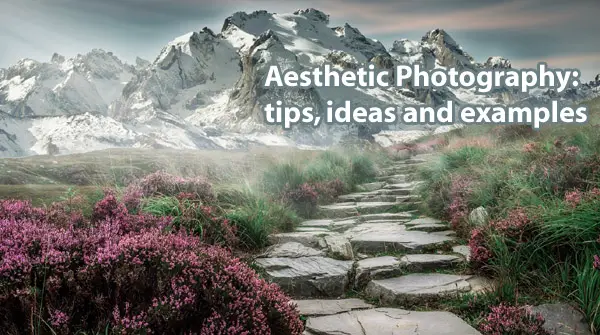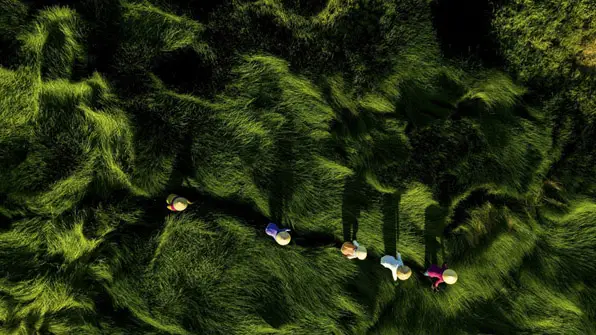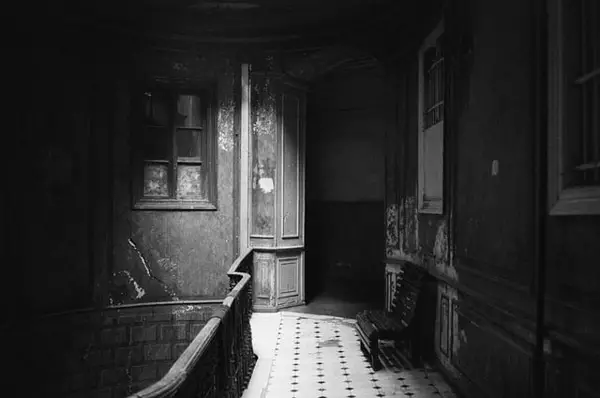These days we are bombarded by visual content. We see images everywhere from giant billboards on the side of the road to handy little Instagram-sized squares in the palms of our hands.
Chances are, every once in a while you see a photo that stops your mindless scrolling in its tracks. You are captivated by what you see and feel compelled to pause a moment to just take it all in.

What you are looking at, my friend, is an aesthetic photo. And if you want to stop other people’s mindless Instagram scroll, you should keep aesthetic photography in mind the next time you pick up your camera.
Now, what is this sorcery?
Simply put, aesthetic photography is images that are pleasing to the eye and make the viewer want to see more. While this definition might seem pretty straightforward — it isn’t. And neither is learning to take aesthetic photographs.
Come along with us as we go deep into aesthetic photography, look at tips on how to take aesthetic photos, as well as browse ideas and examples.
What Is Aesthetic Photography?
So, aesthetic photography involves creating images that are pleasing to the eye. But let’s unpack that a bit more.
What makes an image pleasing to the eye? A beautiful image? Isn’t that what every photographer is trying to create?
Not always. There are many times when a photographer’s purpose is not to create a beautiful image. For example, a forensic photographer’s purpose is to document the scene of a crime accurately, not take pretty pictures.
Furthermore, some genres of photography actively seek to take jarring images that are not pleasing to the eye. For example, photojournalists are documenting what is happening, regardless of whether it is pretty or not. Imagine trying to make photos of soldiers, bombed-out buildings, starving children, or anything else along those lines “pretty.”
Activists may take shocking photos overflowing with emotion designed to tug at your heartstrings and become more sympathetic to their cause. Their primary purpose is not to take beautiful images, but to evoke an emotional response.
However, for those of us who are not seeking raw photos, we are interested in taking aesthetic photographs.
Let’s further examine what that means.
Why Is Aesthetic Photography Important?
We all want people to notice our photographs. That’s why we’re constantly jostling for attention on social media by posting our favorite photos and counting the likes as they roll in.
For some, such as influencers, advertisers, and pretty much any professional photographer looking for clients to hire them, getting noticed is vital.
How do you get noticed? By applying the principles of aesthetic photography to your photos and developing your own aesthetic. You’ll know you’ve arrived when people can start naming you as the photographer just by looking at one of your images.
Aesthetics vs Style
Let’s pause and make a distinction here before you go off down the wrong track. You hear a lot about developing your style as a photographer, but this is not the same thing as your aesthetic.
In fact, every photographer has a style, but not every photographer has an aesthetic.
Your style has more to do with the technical side of things. For example, it’s how you approach a shoot, the equipment you use (or don’t use), your preferred settings, etc.
Your aesthetic is something different. It is made of up many elements and not all of them have to be present in every single aesthetic photograph. It can be the type of subject that you like to shoot or the genre in which you specialize. For example, you may be a nature photographer who likes bold colors or creates soft portraits of people using pretty pastels.
It’s also the way you use light, color, composition, and other elements to make a photo pop. Maybe it’s how you use bokeh or the way you desaturate your greens. It’s the “I can’t quite put my finger on it” that makes your images stand out from the rest.
That’s why we say, give yourself a pat on the back if people start recognizing your photos as yours without knowing you took them. You have managed to create and maintain a strong aesthetic.
Composition vs Aesthetics
Composition is critical when taking aesthetic photos, but it is not synonymous with aesthetics. Imagine again a photojournalist using the rules of composition to create powerful images that are not pleasing to look upon. However, they still manage to draw the viewer in because of the composition the photographer used.

For example, this photograph uses the often quoted rule of thirds, one of the most basic composition rules we learn. However, the face of this child does not invoke warm, fuzzy feelings inside or make you stop and say “what a gorgeous photo!” Instead, you wonder why he looks so sad and why he is stuck behind a barbed-wire fence.
How to Make My Photos More Aesthetic?
It’s important to note that while a photo with good composition may not be aesthetic, an aesthetic photo will generally not have bad composition. A photo with bad composition will always be a photo with a bad composition no matter how you look at it.
Thus, it is still critical for all photographers to learn the rules of composition — and when it’s okay to break them. You might have an eye for images, but until you truly understand the rules of photography, you will have a hard time creating a solid, pleasing aesthetic.
So, to make your photos more aesthetic, you’ve got to go back to the basics. Let’s look at a few compositional elements that will help you create more aesthetic photos.
The Rule of Thirds
We already mentioned it and you probably know it, but it’s so basic and pervasive that we’ve got to mention it.
To use the rule of thirds, use two vertical lines and two horizontal lines to divide your photo into nine equal rectangles. You can either do this visually with imaginary lines or most cameras and smartphones have a setting that allows you to superimpose the grid in the viewfinder or on your screen.
Now you place your subject i.e. the most important part of the image at one of the four points where those lines intersect.
Leading Lines
Leading lines are an excellent way to draw the reader’s eye to the most important point in the image. The lines can be anything — the grain of a hardwood floor, the top of a stone wall, a fence, railroad tracks, or even a line of flowers. Get creative and play with both obvious and not-so-obvious leading lines.
The main thing is to ensure that your camera is angled just right so that the lines draw your viewer’s eye to the exact point you want it to go.
Gestalt Theory in Photography
When was the last time you took a psychology class? Chances are, you didn’t realize what you were learning could be applied to photography! However, understanding how we observe and think is one of the keys to creating great aesthetically-pleasing photos.
The Gestalt theory in psychology covers several basic principles.
- We like symmetry and order, so we’ll look for it in a photograph
- We look for shapes, balance, and associations that are familiar to us
- If a familiar shape is suggested, we will automatically complete it
- We automatically group objects together that are in the same geographic location
- We also group things that have a similar personal or cultural meaning together
- The foreground stands out the most
- Our brains will simplify a complex image to better understand it
When you understand these principles about how the brain works, you can use them to create aesthetically pleasing images. For example, include familiar shapes and symmetry in your compositions to please the brain or place similar objects close together, allowing them to be processed as a group.
Create Odd Photographs
Peculiar photos will probably help your images stand out — although we’re not sure how much positive attention you might receive. What we mean by odd photographs is that you should always choose an odd number of subjects to create your photo.
For whatever reason, we tend to perceive odd numbers of things as a group more easily. Not having to work as hard to understand the image helps make it look more natural to our eye and improves its aesthetic appeal.
Furthermore, where you position the subjects in the image can also contribute to its aesthetics. For example, negative space around the subjects makes them stand out boldly. You also might try to place them in a line or play with the focus until they fall in the foreground, middle ground, and background.
Look for Triangles
Triangles are a strong shape that you can find nearly anywhere if you keep an eye out for them. Remember, shapes in your images don’t have to be explicitly drawn out. All you have to do is suggest the shape and the viewer’s brain does the rest.
Bold triangles with strong lending lines add strength to an image. One with equal or nearly-equal sides adds balance and stability to the image.
When you start paying attention, you’ll probably start seeing triangles everywhere. It is amazing how much we miss simply because we aren’t watching out for it.
How to Take Aesthetic Photos of Yourself
Whether you are an Instagram influencer or a professional photographer, taking aesthetic photos of yourself can be a big part of developing your own aesthetic. These days, consumers want a chance to get to know the faces behind the brands that they buy from. That means you need your smiling face plastered on your website and social media accounts.
But taking aesthetically pleasing photos of yourself can be challenging. Not only are you your own worst critic, but also it’s harder to properly compose selfies and self-portraits. However, just because it’s difficult doesn’t mean you can throw all the basic principles of photography out the window when it comes to taking selfies.
Remember, lighting and angles are key. Avoid taking selfies in fluorescent lighting as this creates harsh shadows on the face and can drain the color from your skin and lips. Instead, stand next to a large window that is letting in lots of natural light that more softly caresses your features.
Avoid holding your phone while taking a selfie. That weird blob of your arm always makes the photo look a little strange. Instead, use a tripod and the countdown timer on your camera or phone.
Here is a great breakdown of how to set up your own selfie shoot at home and create aesthetically pleasing photos for your Instagram and website.
Aesthetic Photography Tips
Beyond composition, there are many other tips and tricks you can use to make aesthetic photographs. Let’s explore some of them here.
Experiment with Different Angles
One way to make a photo of a common subject different from the rest is to photograph it from a different angle than is typical. For example, people usually photograph flowers straight on to show off the beauty of their petals in all their glory. But what if you tried taking a picture of the side of the flower or the back? That might seem strange, but depending on the type of flower you choose and how you do it, the photo could be quite intriguing.
Same thing with people, animals, and other subjects. We usually photograph people at eye level. However, shooting at a downward angle has a slimming effect and can be a great trick when photographing someone with a few extra pounds. Shooting upward makes the person seem larger and maybe more imposing. Many men will appreciate a power photo like this for their website.
Drone photography is really taking off (no pun intended) and is allowing photographers to capture images that were previously impossible for the average person. They are useful for many types of photography, including landscape and real estate photography. How about a photo of a familiar landscape from 20 or 30 feet up? Imagine how the perspective changes and how it could stop someone’s Instagram scroll.
Even just this simple view of a group of women working in a field is far more interesting when the photo is taken from overhead.

Go for the Detail Shot
Another way to change up photos of familiar subjects is to focus on the details instead of the whole subject. Even if you don’t have a dedicated macro lens, you can play with the macro setting on your camera or smartphone to get pseudo-macro photos. Another fabulous option is to use a set of macro filters. Buy a set in the right size to screw on the end of your favorite lens. This will magnify your subject and allow you to get incredible macro photos without an expensive macro lens!
Of course, macro isn’t the only way to get close. Try focusing on one element in a large scene, or getting up close with subjects that are usually photographed from farther away. There is a lot of variabilities here so have fun and be creative!
Carefully Plan Your Images
Most of the outstanding images you see scrolling through Instagram look impromptu and unstaged. It’s not like fashion photography where the scene is obviously styled and the model posed for a certain look.
However, that’s part of the deal. An aesthetic photograph takes planning, even if part of the plan is to make it look unstaged. Off-the-cuff aesthetically pleasing photographs can happen, but they are generally the exception.
You’ll need to sit down before your shoot and hash out a few ideas. What items do you want to include? How do you want to stage them? What about location? And lighting? What elements do you need to support the look you’re going for?
Aesthetic Photography Ideas
There are a number of elements you can use to develop a specific aesthetic. Let’s go over a few to help you as you plan your own aesthetic photographs.
Subjects
What are your favorite subjects to photograph? Do you love photographing people, flat lays, animals, landscapes, products, or anything else specific?
How you like to photograph them also plays a part. For example, you can focus on posed photographs of people or more dynamic lifestyle images.
Compositions
How many photography composition rules can you name off the top of your head? This a great game to test your photography knowledge. Plus, the first rules you mention will probably be the ones you use the most!
Lighting
Photography is painting with light and there are lots of different styles. The big debate is between natural and artificial lighting and many photographers use strictly one or the other. Others use a mix of these two mediums to create specific looks.

Focus
Some photographers prefer tack sharp images whereas others love a softer image. Not that it’s out of focus, just that it has a softer feel. For example, a newborn photographer would probably choose a softer look for their portraits, but a fine art portrait photographer might want crisp images.
Colors
Some photographers LOVE bold colors. Others gravitate toward pastels. Some like to play with the saturation slider and give their images either a muted look or a strong one. You have a lot of leeway with colors so be sure to play with them to discover what you love!
Aesthetic Photography on Instagram
Here are some of our favorite artists with strong aesthetics.
https://www.instagram.com/p/CM4F2A4jH5m/
If you’re familiar with Daniel Venter’s work, you already know this is his photo. He has a very strong aesthetic where he uses a shallow depth of field to soften the background and make his subjects jump right out of the image. The result is a breathtaking photo every time.
https://www.instagram.com/p/B-icUX5HM1J/
This photographer from Julie Lynn Photography uses gorgeous golden tones in all of her photos. Somehow, she has figured out how to give her photos a bronzed look without making her subjects look overly orange. We think the result is stunning!
https://www.instagram.com/p/CFatp2BD4AO/
Mary Ella lives in Hawaii and takes lots of photos of couples and families on the beach. Her photos are characterized by bold, bright colors- strong sunset colors in the sky complemented by an aqua or teal ocean. The look is captivating and unmistakable!
https://www.instagram.com/p/CKYNiaJF6Tb/
Lillian Liu is a creative photographer with a portfolio full of ethereal, fantasy images. She often uses muted or dark colors and gives her images almost a painting-like effect. Her models are always dressed in fantastical costumes with over-the-top jewelry and accessories and often have angsty or sensual expressions.
https://www.instagram.com/p/CKpRn5nJ64h/
Serge Ramelli is a French photographer known for his stunning landscapes and photos of famous buildings and landmarks in France. His signature move is to crush the highlights and bring up the shadows. He also creates brilliant sunsets by strategically adding lots of yellow and magenta to the sky.
https://www.instagram.com/p/CMxbaClhRJ4/
Thien Lai, the incredibly talented photographer behind the stunning images captured by Element Creative Commercial photography, has a very clean aesthetic. The colors are bold, with enough contrast to make them powerful. He likes to capture details to draw attention to every element of a product.
https://www.instagram.com/p/CM7SOLjFNrO/
If you want to see vibrant colors come to life, check out the amazing work of Adam Opris. The colors are vivid and incredibly alive, without looking oversaturated and false. Every photo is bright and clear and he uses a lot of creative angles and poses to bring new life to wedding and maternity photography.
Develop Your Own Aesthetic
Are you feeling thoroughly inspired yet? These amazing photographers have all carved out a niche for themselves in an incredibly competitive field. The good news is…there’s room for you! Every artist can have their own unique vibe, it’s just a matter of pinpointing yours.
Once you get good at creating aesthetic images, you’ll get a feel for the aesthetic that you like and what works well with your style of photography. At that point, you can start developing your own aesthetic. Once it becomes prominent enough, people familiar with your work will start to pick out your images without being told that you were the photographer.
How do you figure out what you naturally gravitate to? A good way to do this is to look through your Instagram feed or any other collection of your favorite images. Look for similar elements such as the type of lighting, subjects, colors, etc. What ties the photographs together? Look for the common themes, and you’ll discover your aesthetic.
By the way, you might discover that you have several different favorite aesthetics. If that’s the case, and you want to develop a specific one, you’ll have to choose which aesthetic you want and aim for it with all your photos.
Learn to Edit
A lot of the aesthetic has to do with how you edit the photos. The most basic step of this is to use the same filters every time in your favorite smartphone editing software.
However, if you want to create a definitive and cohesive aesthetic with a unique look, you’re going to need to learn to edit using more sophisticated software. That’s how you get bold colors, desaturated effects, moody looks, vintage-style photos, and any other special effects to build your aesthetic.
The big names in photo editing are Lightroom and Photoshop. They are both made by the same company but can be used in distinctly different ways. Check out our comparison of Photoshop vs Lightroom to find out how they stack up.
Remember, always take your photos in RAW format to give you the most flexibility in post-production. With a JPEG there is a lot of compression, the dynamic range is limited, and editing will result in further loss of quality.
Use Presets
Presets are a great way to get started in editing. They can speed up your workflow significantly since you don’t have to start from scratch with every single photo. You can also learn new techniques and understand how the different sliders work together by examining the effect a preset has on your photo.
However, remember that presets are a starting point. Don’t just buy presets to copy your favorite artist. There are plenty of aesthetics in the world to go around. You don’t need to copy someone else. Find your own artistic voice and let it sing!
Click here for some free lightroom presets.
Aesthetic Photography Is a Journey
Do not get discouraged if it takes you a while to find your groove. Photography is a journey: First to discover the aesthetic that makes your heart sing. Next, you have to figure out how to consistently get the same look for all your photos. Then, finally, become known to the world.
Many of us never reach that last step, and that is okay! Photography is your art, your way of expressing yourself, and your aesthetic will always be yours — it does not matter how many followers you have on Instagram.
Looking to up your portrait-taking prowess? Check out these tips on creating more artistic portraits!









3 comments